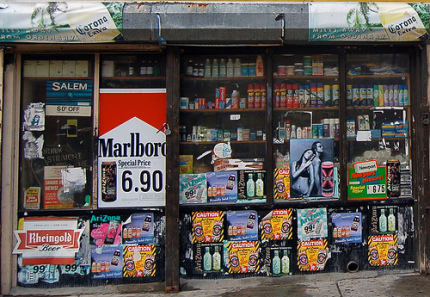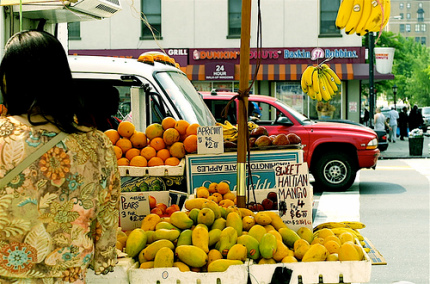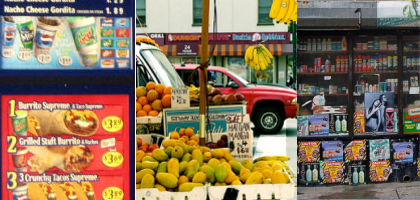Creating Healthy Bodegas

At Harmony Variety Discount in East Harlem, the meat and cheese case is empty, but the beer refrigerators are packed. A sign outside the Lexington Avenue Bodega calls in customers for 99-cent, 24-ounce cans of Miller Lite and packs of Newports for $6.50.
For eight years, owner Mohammed Saleh has provided the low-income neighborhood with a place to grab a six-pack and cigarettes -- not fresh fruits or vegetables.
He tried to sell healthy foods for six months last year, but no one bought them.
"Nobody buys them," said Saleh of fruits, vegetables and even low-fat milk. "If you ordered healthier food, the store would lose money."
Saleh's second location on the Upper East Side, however, sells such healthy products successfully. Grocers on the Upper East Side may stock leafy lettuce and ripe grapes, but 20 blocks north, similar products are noticeably absent.
The Grocery Gap
Residents of Harlem, Central Brooklyn and the South Bronx often have no choice but to shop at stores like Harmony Variety Discount, which fail to provide healthy options.
Supermarkets are few and far between - some city zip codes are without them entirely - leaving many residents scrounging for affordable meals at fast food restaurants, small grocers or bodegas. Instead of the Whole Foods or Associated Supermarkets found in more affluent areas, many residents in Harlem must rely on Popeye's or McDonald's - options that do not reinforce a healthy lifestyle.
In response, the Bloomberg administration in 2006 launched a healthy bodegas initiative in Harlem, the South Bronx and Central Brooklyn. Its goal: to make fruits, vegetables and low fat milk more accessible in an effort to stifle the epidemics of diabetes and obesity - diseases directly associated with diet.
Since the program began, the Department of Health and Mental Hygiene contends it has been a success. But does measuring the number of participating bodegas accurately measure whether fruits and vegetables are served at kitchen tables throughout the city?
What's In Stock?
In both Harlem and the northern and central sections of Brooklyn, bodegas are the main place to purchase food. According to a health department study released in 2007, two out of three food retailers in East and Central Harlem are bodegas in comparison to one in three food stores on the Upper East Side. In Bedford-Stuyvesant and Bushwick, approximately 80 percent of food stores are bodegas. Only 28 percent of those bodegas carry apples, oranges and bananas, according to a similar study on access to healthy foods in Brooklyn by the health department.
These neighborhoods are also more likely to be overrun by diseases that flourish among those with unhealthy eating habits. A resident of the South Bronx, for instance, is about six times more likely to suffer from diabetes than a resident of the city's more affluent neighborhoods.
Arguing that access can make all the difference, the Bloomberg administration launched the multi-faceted healthy bodega campaign, specifically aimed at getting low and reduced fat milk in bodegas in low-income neighborhoods alongside fruits and vegetables. Over the course of two years - the original deadline is this December - it hoped to cover 1,000 stores.
It tested several approaches, like selling sliced individual apples in bodegas, some with greater success than others. Overall, said advocates, the milk initiative seems to be having more of an impact than efforts to get produce in the stores, and the health department says it has reached its target to get storeowners committed to selling low fat milk. (So far, the fruits and vegetables program has also not been rolled out entirely - it should be out in full-force this spring.)
The department launched its fruit and vegetable pilot program last year at 60 locations, which, officials admit, was not entirely successful. The revamped full-fledged initiative will affect far fewer stores than some advocates initially expected. A health department official said about 450 bodegas will participate, all of which already sell some fruits or vegetables.
The cost of the initiative, according to the health department, is less than $300,000 annually, which is attributed entirely to staffing.
"We have seen more low-fat milk on their shelves," said Charmaine Ruddock, the project director of Bronx Health REACH, a community group that has launched its own healthy bodega program in the South Bronx. "There is an increase in awareness of eating healthier. The challenge, of course, is getting these healthy foods in there."
And Its Impact
Few would argue against eating healthy foods and making them more accessible (Though some did so this week at City Hall - see related stories here and here.) The challenges the health department faces are not over its goals but on its ability to make them a reality and enforcement.
The campaign is not penalty oriented. So, said Sabrina Baronberg, the deputy director of the physical activity and nutrition program at the health department, enforcement is done by follow-up visits from health department officials and through a questionnaire.
Even if bodega owners do stand by their commitment, it's difficult to gauge whether demand will naturally follow supply.
"We know there is focused demand in the community," said Baronberg. "It's not true that people in these communities are not interested."
What is true, said some advocates, is participating has proved to be difficult for some owners. Some bodegas do not have adequate space for fresh produce, while others cannot afford to lose profits on a product whose shelf life is relatively short.
"Lets say you stock up on watermelons for Memorial Day and it rains," said Joel Berg, the executive director of the New York City Coalition Against Hunger. "If you're a small bodega, you're out."
In East Harlem, some storeowners echoed that sentiment. Some storeowners said they don't have the space to expand beyond candy, toilet paper and other grocery items. At Harmony Victory Discount, price is a deterrent to selling fruits and vegetables, which are more expensive than other types of food.
"Eating healthy is expensive," said Ali Saleh, the owner's brother. "People come in here with $3, and they still owe us a quarter."
Health department officials said they are exploring ways to help bodegas get loans so they can afford to either purchase fruits and vegetables or revamp their stores to make room for them. Those loans, though, will not necessarily make such food more affordable to their customers.
Transforming Neighborhoods
Many say it's still too early to tell whether the city's healthy bodega initiative is getting more residents of low-income neighborhoods to eat healthier. Either way, some said, it certainly can't hurt to try.
This program is just one of many in the administration's public health crusade, which advocates characterize as one of the most progressive in the country. While this particular initiative is no panacea, they say it is certainly positive.
"It certainly hasn't hurt, but it hasn't transformed bodegas citywide," said Berg.
Â
Fresh Food and Fresh Ideas

As children we learned that an apple a day keeps the doctor away, but we never questioned where that apple would come from or how much it might cost.
While some New Yorkers enjoy the "luxury" of a grocery store just down the block, many low-income families live far from any place to buy healthy, high-quality produce at affordable prices. Hundreds of thousands of New York City residents live in neighborhoods with no supermarket, no green grocer and no farmers market. Families must go to great lengths to purchase food outside their neighborhoods or make do with what corner bodegas supply -- largely canned and boxed goods.
No wonder the New York City Department of Health and Mental Hygiene found that 12 percent of adults in some neighborhoods ate no fruits or vegetables on a daily basis. As one would expect, the existence of these "food deserts" throughout the city has a devastating impact on the health and waistlines of New Yorkers.
According to the health department, about 500,000 children citywide are obese and at risk of developing life threatening diseases - diabetes, heart disease, and high blood pressure - as adults. Life expectancy in some poor communities is eight years shorter than in wealthier neighborhoods, such as the Upper East Side or the West Village. While various factors lead to these problems, research has shown that a diet lacking fresh fruits and vegetables is among the major contributors.
To begin to address this public health crisis, children and families in all New York City neighborhoods must have access to fresh affordable produce. Poor, hard-working families across the city shouldn't have to tackle multiple subway lines, buses or cab fares after work or on the weekend in order to purchase high quality fruits and vegetables at prices they can afford. Rather, families everywhere - in Melrose, Harlem, Bedford-Stuyvesant, Bushwick, Jamaica, Corona and Willowbrook - need healthy food options, at reasonable prices, where they live.
A Cart Around the Corner
Help is finally on the way. Thanks to Mayor Michael Bloomberg and City Council Speaker Christine Quinn's "Green Carts" initiative, families even in places without good grocery stores soon will be able to purchase affordable fresh fruit and vegetables conveniently, and on a regular basis, where they live.
The recently passed green cart legislation will create 1,000 new licenses for vendors to sell fruits and vegetables in neighborhoods that have high rates of obesity and diabetes, and where consumption of fresh produce is low.
While this may not be legislation that will change New York City's food landscape forever, it provides a new solution to the age-old problem of how to provide all neighborhoods - particularly those with a desperate need - access to healthy affordable food. The green carts initiative can be implemented quickly and will have a broad reach in the city's poorest communities.
Increasing Access
The food industry is a powerful lobby, and it had engaged in an all-out fight to derail this legislation. Despite the fact that carts will operate where supermarkets and other fresh food outlets don't exist, the industry argued that the carts will create unfair competition. If only that were true -- there would have been no need for green carts.
Ideally, every neighborhood would have a grocery store or supermarket within walking distance of the majority of its residents. Supermarkets relieve a neighborhood's food deficit, anchor a community and provide good stable jobs. For decades, communities have been lamenting the lack of such stores - especially when other neighborhoods have lavish food outlets on every corner.
The city is studying how to lure supermarkets and green grocers back to our communities, and we're optimistic this will eventually mean more grocery stores where they are needed most. The increased presence of a once or twice-weekly greenmarket would also be a major improvement in neighborhoods lacking options.
But waiting for the perfect answer ignores the immediate healthy dangers these children and families across our city face. It would be the equivalent of arguing that until we have a perfect health care system, people should not seek treatment at all.
Our city's low-income children and families cannot afford to wait three, five or 10 years to get better access to fresh produce. While we hope for supermarkets and farmer's markets in the future, we need to be able to buy apples and bananas for snacks today, and green beans and salad greens for dinner tonight. Lives literally depend on it.
The green cart initiative addresses this real need - in real time.
We are looking forward to seeing these carts in neighborhoods all over the city, where for the first time in decades, hundreds of thousands of families will be able to conveniently buy fresh produce. And at the same time, we will continue to support the mayor and the City Council in their efforts to develop more supermarkets and farmer's markets and improve the capacity of existing grocers to sell fresh produce at prices New Yorkers can afford.
Jennifer March-Joly is executive director of Citizens' Committee for Children of New York, Inc.
Â
Fighting the Obesity Epidemic

Mayor Michael Bloomberg has made public health a signature issue for his administration. During his six years in office, the city has waged war on smoking, focused on improving care at public hospitals and promoted a range of initiatives aimed at getting New Yorkers to take better care of themselves.
Many of these efforts have proved successful. Smoking has declined sharply, the number of AIDS deaths has dropped and an increasing number of New Yorkers see a regular physician. Even traffic deaths have hit a record low. But one area stubbornly resists the improved health picture: obesity.
About one fifth of all New Yorkers is obese, with the rate far higher in some areas. "We see obesity going up across the city, regardless of neighborhood, but also we see disparities between neighborhoods," the health department's Cari Olson said in an interview with Gotham Gazette last year.
As obesity rates rise, so has the prevalence of diabetes. A recent report by the City University and the Public Health Association of New York found the number of New Yorkers with diabetes has risen 250 percent in the last decade and that the death rate from it has almost doubled.
The administration has not ignored the problem. It has, among other things, replaced whole milk with the low-fat variety in school cafeterias, worked to make school food healthier in general, tried to get bodegas to stock more wholesome products and so on.
How successful are these programs? That remains unclear.
The city's most recent Public Health in New York City report featured pages and pages of indicators in a section titled "The Health Department by the Numbers." Few of the statistics concern obesity and fitness. The report does cite the implementation of the FitnessGRAM program in schools and other exercise programs, along with its efforts to remove transfats from city restaurants. But other than that, it has little to say on overweight New Yorkers, and the department's "Ten Steps to a Longer Healthier Life," largely ignores diet and exercise other than to tell New Yorkers to "keep your heart healthy."
In light of that, Gotham Gazette decided to assess some specific city programs intended to curb the obesity epidemic. We found some successes, some failures with work left to be done.
Putting Bodegas on a Diet: Many New Yorkers must shop at small groceries, which offer a smorgasbord of chips but not fresh produce. Can the city make storeowners change their ways?
Reading, Writing -- and Running? The Department of Education has implemented a FitnessGRAM so parents can help their kids shape up. But in an era when standardized tests influence so much of the school day, traditional phys ed classes often fall victim to a lack of time and space.
Affordable Greenmarkets: City and state efforts seek to make the bounty of city farmers markets available to low-income New Yorkers.
Beefing Up the Menu: Calories mount up quickly at fast food restaurants, and the Bloomberg administration hopes people will scale back -- once they know just how fattening their favorites burgers are. But restaurant owners are fighting back.
Also this week:
Curbside Vegetables: Will produce pushcarts encourage people to eat healthier foods?
Permit for "Green Carts": The City Council passes a measure to create a new class of street vendor.
Â




